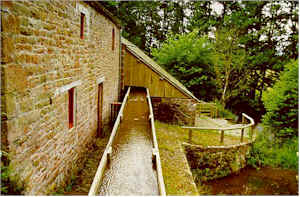This is another National Trust property but unlike most of theirs round here I'd never actually been, and all the pictures looked idyllic. Sure enough, there was a 'big house' in lovely old red sandstone basking in the sunshine, surrounded by immensely pretty gardens. The first area included an old garden pond which was absolutely swarming with newts - something I haven't seen for years - and a sprawling rockery.
There's far more to the garden than flowers, though, because it's known as a nationally important collection of herbs and medicinal plants, containing over 300 different varieties. We saw a sign to the herb garden and thought 'oh yes, parsley and thyme', but there were plants from every corner of the globe, many of which we'd never even heard of, let alone seen growing in this country. The collection is divided into sections depending on the part of the body they treat (head, heart, skin etc) and it was fascinating to see Medieval childbirth remedies cheek-by-jowl with plants used in ultra-modern chemotherapy drugs.
 We could have wandered round the garden (which also included old orchards, beehives, wild-flower
We could have wandered round the garden (which also included old orchards, beehives, wild-flowermeadows etc) for hours but after a nice salad lunch in the tea room we set off through the woods to the old watermill on the banks of the delightfully-named Crowdundle Beck. There's been a mill here since about the twelfth century (the original is believed to have been owned by the Knights Templar) although the current building and workings date from about 200 years ago. While we were there the volunteer miller opened the sluice on the mill leat, diverted water along the newly refurbished chute, and got the waterwheel working so we could see the machinery turning. Originally there were three separate wheels, each connected to different workings with a different job to do, but only one remains. It was still fascinating, though, listening to the clunk-creak as it span lazily round, and imagining how it would all have looked and sounded a century or so ago when they still used the building regularly to grind corn. Swallows buzzed in and out of the windows just above our heads, chickens pecked and scratched in the farm yard at the back, and it was all so Yesterday's Rural Idyll it practically hurt.
Lovely place, though, and well worth a visit.

No comments:
Post a Comment